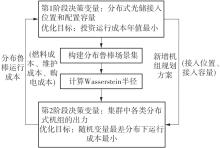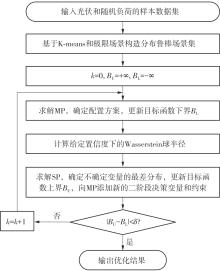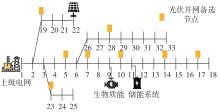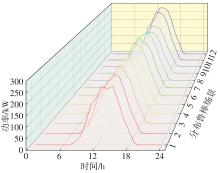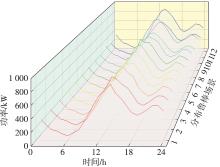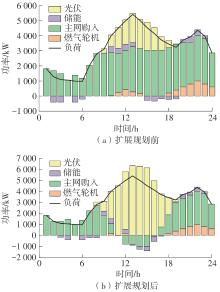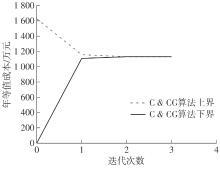| 1 |
盛万兴 .可再生能源集群发电技术与实践[M].北京:科学出版社,2020.
|
| 2 |
盛万兴,吴鸣,季宇,等 .分布式可再生能源发电集群并网消纳关键技术及工程实践[J].中国电机工程学报,2019,39(8):2175-2186.
|
|
SHENG Wanxing, WU Ming, JI Yu,et al .Key techniques and engineering practice of distributed renewable generation clusters integration[J].Proceedings of the CSEE,2019,39(8):2175-2186.
|
| 3 |
吴文传,李志刚,王中冠 .可再生能源发电集群控制与优化调度[M].北京:科学出版社,2020.
|
| 4 |
鲁明芳,李咸善,李飞,等 .季节性氢储能-混氢燃气轮机系统两阶段随机规划[J].中国电机工程学报,2023,43(18):6978-6992.
|
|
LU Mingfang, LI Xianshan, LI Fei,et al .Two-stage stochastic programming of seasonal hydrogen energy storage and mixed hydrogen-fueled gas turbine system[J].Proceedings of the CSEE,2023,43(18):6978-6992.
|
| 5 |
凌万水,刘刚 .基于鲁棒优化的主动配电网分布式电源优化配置方法[J].电力系统保护与控制,2020,48(15):141-148.
|
|
LING Wanshui, LIU Gang .Distributed generation optimal configuration method for active distribution networks based on robust optimization[J].Power System Protection and Control,2020,48(15):141-148.
|
| 6 |
彭春华,陈露,张金克,等 .基于分类概率机会约束IGDT的配网储能多目标优化配置[J].中国电机工程学报,2020,40(9):2809-2819.
|
|
PENG Chunhua, CHEN Lu, ZHANG Jinke,et al .Multi-objective optimal allocation of energy storage in distribution network based on classified probability chance constraint information gap decision theory[J].Procee-dings of the CSEE,2020,40(9):2809-2819.
|
| 7 |
朱嘉远,刘洋,许立雄,等 .风电全消纳下的配电网储能可调鲁棒优化配置[J].电网技术,2018,42(6):1875-1883.
|
|
ZHU Jiayuan, LIU Yang, XU Lixiong,et al .Adjus-table robust optimization for energy storage system in distribution network based on wind power full accommodation[J].Power System Technology,2018,42(6):1875-1883.
|
| 8 |
周安平,杨明,翟鹤峰,等 .计及风电功率矩不确定性的分布鲁棒实时调度方法[J].中国电机工程学报,2018,38(20):5937-5946.
|
|
ZHOU Anping, YANG Ming, ZHAI Hefeng,et al .Distributionally robust real-time dispatch considering moment uncertainty of wind generation[J].Proceedings of the CSEE,2018,38(20):5937-5946.
|
| 9 |
DING Yifu, MCCULLOCH M D .Distributionally robust optimization for networked microgrids considering contingencies and renewable uncertainty[C]∥Proceeding of the IEEE Conference on Decision and Control.Texas:IEEE,2021:2330-2335.
|
| 10 |
陈泽雄,张新民,王雪锋,等 .分布式光伏电站接入配电网的分布鲁棒优化配置方法[J].电力系统保护与控制,2021,49(13):30-42.
|
|
CHEN Zexiong, ZHANG Xinmin, WANG Xuefeng,et al .A distributionally robust optimal allocation method for distributed photovoltaic generation stations integrated into a distribution network[J].Power System Protection and Control,2021,49(13):30-42.
|
| 11 |
杨智麟,张英敏,何川 .基于风功率间歇性的多区域综合能源系统两阶段分布鲁棒协同优化调度的研究[J].智慧电力,2021,49(10):59-67.
|
|
YANG Zhilin, ZHANG Yingmin, HE Chuan .Two-stage distributed robust coordinated optimal dispatch for multi-regional integrated energy system considering intermittent wind power[J].Smart Power,2021,49(10):59-67.
|
| 12 |
曹金声,曾君,刘俊峰,等 .考虑极限场景的并网型微电网分布鲁棒优化方法[J].电力系统自动化,2022,46(7):50-59.
|
|
CAO Jinsheng, ZENG Jun, LIU Junfeng,et al .Distributionally robust optimization method for grid-connected microgrid considering extreme scenarios[J].Automation of Electric Power Systems,2022,46(7):50-59.
|
| 13 |
于馨玮,陈继明,仉志华 .分布鲁棒优化在综合能源系统调度与规划中的应用综述[J].全球能源互联网,2023,6(2): 207-215.
|
|
YU Xinwei, CHEN Jiming, ZHANG Zhihua .A review of the application of distributionally robust optimization in integrated energy system dispatching and planning[J].Journal of Global Energy Interconnection,2023,6(2):207-215.
|
| 14 |
贺帅佳,阮贺彬,高红均,等 .分布鲁棒优化方法在电力系统中的理论分析与应用综述[J].电力系统自动化,2020,44(14):179-191.
|
|
HE Shuaijia, RUAN Hebin, GAO Hongjun,et al .Overview on theory analysis and application of distributionally robust optimization method in power system[J].Automation of Electric Power Systems,2020,44(14):179-191.
|
| 15 |
丁明,解蛟龙,刘新宇,等 .面向风电接纳能力评价的风资源/负荷典型场景集生成方法与应用[J].中国电机工程学报,2016,36(15):4064-4072.
|
|
DING Ming, XIE Jiaolong, LIU Xinyu,et al .The generation method and application of wind resources/load typical scenario set for evaluation of wind power grid integration[J].Proceedings of the CSEE,2016,36(15):4064-4072.
|
| 16 |
陈熠,王晗,徐潇源,等 .省间-省内两级市场协调下两阶段分布鲁棒经济调度模型[J].上海交通大学学报,2023,57(9):1114-1125.
|
|
CHEN Yi, WANG Han, XU Xiaoyuan,et al .A two-stage distributionally robust economic dispatch model under the coordination of inter-provincial and intra-provincial bi-level market[J].Journal of Shanghai Jiaotong University,2023,57(9):1114-1125.
|
| 17 |
梁子鹏,陈皓勇,郑晓东,等 .考虑风电极限场景的输电网鲁棒扩展规划[J].电力系统自动化,2019,43(16):58-67.
|
|
LIANG Zipeng, CHEN Haoyong, ZHENG Xiaodong,et al .Robust expansion planning of transmission network considering extreme scenario of wind power[J].Automation of Electric Power Systems,2019,43(16):58-67.
|
| 18 |
ZHANG Y P, AI X M, FANG J K,et al .Data-adaptive robust optimization method for the economic dispatch of active distribution networks[J].IEEE Transactions on Smart Grid,2019,10(4):3791-3800.
|
| 19 |
YAO L, WANG X L, DUAN C,et al .Data-driven distributionally robust reserve and energy scheduling over wasserstein balls[J].IET Generation Transmission & Distribution,2018,12(1):178-189.
|
| 20 |
ZENG B, ZHAO L .Solving two-stage robust optimization problems using a column-and-constraint generation method[J].Operations Research Letters,2013,41(5):457-461.
|
| 21 |
ZHU R J, WEI H, BAI X Q,et al .Wasserstein metric based distributionally robust approximate framework for unit commitment[J].IEEE Transactions on Power Systems,2019,34(4):2991-3001.
|
